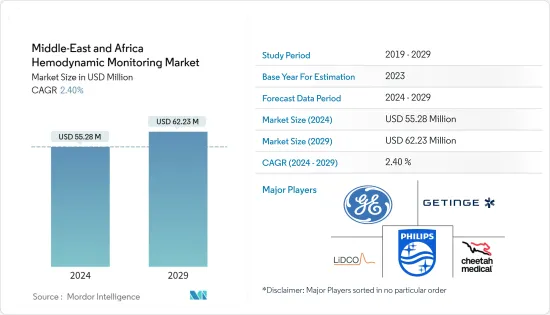PUBLISHER: Mordor Intelligence | PRODUCT CODE: 1432484

PUBLISHER: Mordor Intelligence | PRODUCT CODE: 1432484
Middle-East & Africa Hemodynamic Monitoring - Market Share Analysis, Industry Trends & Statistics, Growth Forecasts (2024 - 2029)
The Middle-East & Africa Hemodynamic Monitoring Market size is estimated at USD 55.28 million in 2024, and is expected to reach USD 62.23 million by 2029, growing at a CAGR of 2.40% during the forecast period (2024-2029).

The key factors propelling the growth of this market are an increase in the number of critically ill geriatric cases, rise in the prevalence of cardiac disorders and diabetes, increasing demand for home-based and non-invasive monitoring systems, advances in technology, due to funding by private players and government bodies, and increase in the number of people suffering from hypertension.
According to the World Population Ageing 2019 report, in Saudi Arabia, the population aged 65 years or over in 2019 was 1.169 million (3.4%), and this number is projected to reach to 2.379 million (6.0%) in 2030. As the elderly population is expected to grow in the coming years, and the elderly are more prone to chronic diseases, such as cardiovascular diseases, obesity and diabetes, the market is expected to experience growth in the future.
Thus, owing to the above factors the market is expected to show significant growth over the forecast period.
MEA Hemodynamic Monitoring Market Trends
Minimally Invasive Monitoring Systems is Expected to Hold Significant Market Share in the System Segment
The minimally invasive systems help in tracking stroke volume continuously and offer dynamic information of fluid responsiveness. Some of the systems provide the assessment of volumetric preload variables, while others highlight the continuous measurement of central venous saturation with proprietary catheters. These variables of minimally invasive systems, along with cardiac output, deliver improved hemodynamic monitoring.
As per Statistics South Africa, in 2018 approximately 4.38 million South Africans suffered from hypertension, making it the most prevalent chronic health condition in the country.
In Middle-East & Africa, LiDCO Group PLC offers the minimally invasive "LiDCOplus" hemodynamic monitor provides a continuous, reliable and accurate assessment of the hemodynamic status of critical care and surgery patients. The LiDCOplus is comprised of two technologies a continuous arterial waveform analysis system (PulseCO) coupled to a single point lithium indicator dilution calibration system.
Thus, owing to the above-mentioned factors the segment is expected to show growth in the coming years.
MEA Hemodynamic Monitoring Industry Overview
The Middle-East & African Hemodynamic Monitoring Market is highly competitive and consists of several major players. In terms of market share, few of the major players currently dominate the market. However, with technological advancements and product innovations, mid-size to smaller companies are increasing their market presence by introducing new devices with fewer prices. Companies, like Getinge Group, Koninklijke Philips NV, LiDCO Group PLC and GE Healthcare, hold substantial shares in the market.
Additional Benefits:
- The market estimate (ME) sheet in Excel format
- 3 months of analyst support
TABLE OF CONTENTS
1 INTRODUCTION
- 1.1 Study Assumptions
- 1.2 Scope of the Study
2 RESEARCH METHODOLOGY
3 EXECUTIVE SUMMARY
4 MARKET DYNAMICS
- 4.1 Market Overview
- 4.2 Market Drivers
- 4.2.1 Increasing Geriatric Population and Rise in the Prevalence of Cardiac Disorders and Diabetes
- 4.2.2 Increasing Demand for Home-based and Non-invasive Monitoring Systems
- 4.2.3 Increasing Number of People Suffering from Hypertension
- 4.3 Market Restraints
- 4.3.1 Increasing Incidences of Complications Associated with Invasive Monitoring Systems
- 4.3.2 Precision of CO Determinations Adversely Affected Under Low Flow Conditions
- 4.4 Porter's Five Force Analysis
- 4.4.1 Threat of New Entrants
- 4.4.2 Bargaining Power of Buyers/Consumers
- 4.4.3 Bargaining Power of Suppliers
- 4.4.4 Threat of Substitute Products
- 4.4.5 Intensity of Competitive Rivalry
5 MARKET SEGMENTATION
- 5.1 By System
- 5.1.1 Minimally Invasive Monitoring Systems
- 5.1.2 Invasive Monitoring Systems
- 5.1.3 Non-invasive Monitoring Systems
- 5.2 By Application
- 5.2.1 Laboratory-based Monitoring Systems
- 5.2.2 Home-based Monitoring Systems
- 5.2.3 Hospital-based Monitoring Systems
- 5.3 Geography
- 5.3.1 Middle-East & Africa
- 5.3.1.1 GCC
- 5.3.1.2 South Africa
- 5.3.1.3 Rest of Middle-East & Africa
- 5.3.1 Middle-East & Africa
6 COMPETITIVE LANDSCAPE
- 6.1 Company Profiles
- 6.1.1 Getinge Group
- 6.1.2 Koninklijke Philips NV
- 6.1.3 GE Healthcare
- 6.1.4 Cheetah Medical Inc
- 6.1.5 LiDCO Group PLC
- 6.1.6 Draeger Medical
- 6.1.7 Schwarzer Cardiotek GmbH
- 6.1.8 Tensys Medical Inc
7 MARKET OPPORTUNITIES AND FUTURE TRENDS




